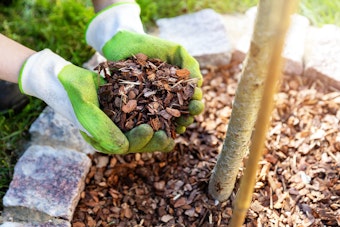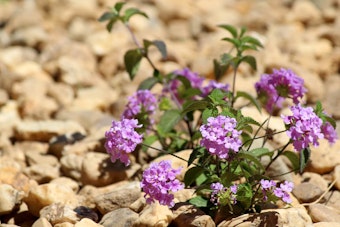 Be Inspired Blog - Arizona
Be Inspired Blog - Arizona

Creating Microclimates in Your Arizona Yard & Garden
Living in Arizona can be challenging for gardening and landscaping enthusiasts due to our intense heat, dry conditions, and unique desert climate. However, creating microclimates in your yard and garden can help mitigate these harsh environmental factors, allowing a wider variety of plants to thrive.
 What is a Microclimate?
What is a Microclimate?
Microclimates are localized zones with slightly different conditions than the surrounding areas (in terms of temperature, humidity, wind, sunlight, etc.). Fortunately, you can cultivate microclimates to create more comfortable spaces for both you and your plants!
Here’s how to create microclimates to enhance your landscape's diversity and resilience.
1. Leverage Shade and Shelter
The desert sun is unrelenting, especially in the summer. Shade is one of the most powerful tools you can use to create a cooler microclimate. Adding shade to your garden and landscape reduces stress on plants and lowers temperatures in your yard.
 Ways to Create Shade
Ways to Create Shade
- Trees and Large Shrubs: Native or drought-tolerant trees such as Palo Verde, Mesquite, or Desert Willow can provide natural shade. Another great option is the Moringa tree. The filtered light from these trees helps shield delicate plants underneath from the intense sun while still allowing airflow.
- Pergolas and Shade Structures: Install pergolas, shade sails, or trellises where you can grow sun-loving vines like Bougainvillea, Grape, Tangerine Beauty Crossvine, and others. These structures create partial shade and reduce the ambient temperature for surrounding plants.
- Vertical Gardening: Utilize walls or fences as support for climbing plants or vertical gardens. They provide shelter from harsh winds and can reduce heat by shading the walls.
This reduction in sunlight directly influences temperatures, offering a cooler spot in your garden where even moisture-loving plants can survive.
 2. Plant Grouping and Layering
2. Plant Grouping and Layering
Grouping plants with similar water, sun, and wind requirements together creates a natural microclimate. It helps with maintaining a consistent environment, reduces competition among plants, and maximizes water efficiency.
- Canopy Layering: Mimic natural ecosystems by using a canopy of trees to shade medium-sized shrubs, which in turn protect low-growing groundcovers. This layered system shields more delicate plants from direct sunlight and provides a more humid microclimate.
- Companion Planting: Combine plants that benefit from each other. For instance, pairing sun-loving plants like cacti with understory plants that require partial shade helps create natural microclimates in small areas.
- Drip Irrigation for Your Plants: Watering your plants through a drip irrigation system ensures efficient water usage, and healthy plants.
 3. Embrace Native and Drought-Tolerant Plants
3. Embrace Native and Drought-Tolerant Plants
While microclimates allow for some non-native plants, it’s essential to embrace the use of native and drought-tolerant plants that already thrive in the Valley’s climate. Plants like Agave, Yucca, and Red Yucca not only survive but can help create microclimates for more sensitive species.
 4. Water Features for Humidity
4. Water Features for Humidity
The desert is dry, but by adding water features, you can increase localized humidity, benefiting plants that prefer a bit more moisture.
- Pools, Ponds & Water Gardens: A pool, small pond or fountain can elevate humidity levels in a limited area. Even though the Valley is arid, a carefully designed water feature can serve both aesthetic and functional purposes without using excessive water.
- Misting Systems: Installing a misting system around outdoor living spaces or near your garden can create a localized humid environment. It's particularly useful for cooling down an area where you might relax or grow plants like ferns, which appreciate a little extra moisture in the air.
 5. Soil Management and Mulching
5. Soil Management and Mulching
Soil in the desert tends to be sandy and drains quickly, meaning moisture evaporates faster. Improving your soil and using mulch can help regulate temperature and moisture levels, creating a more suitable microclimate for your plants.
- Soil Amendments: Enrich the soil by adding organic matter such as compost or aged manure to improve water retention. Better soil quality will keep roots cooler and retain moisture longer.
- Mulching: Apply a thick layer of organic mulch (like wood chips or straw) around the base of plants. Mulch acts as an insulator, keeping the soil cooler and retaining moisture, especially in the peak heat of summer.
 6. Incorporate Small Patches of Usable Lawn
6. Incorporate Small Patches of Usable Lawn
Even in the desert environment, small patches of usable lawn can be an excellent way to create a cooler microclimate and add functional space for kids, pets, or a mini oasis. While a full lawn might not be sustainable in Phoenix, small, well-placed patches (also known as Limited Turf Areas) can provide several benefits:
- Cooler Surface Temperatures: Grass absorbs less heat than hardscaping or bare ground, creating a cooler microclimate. A small patch of lawn can serve as a comfortable area for children or pets to play, offering a break from pavement or gravel that is often too hot for pets to walk on during our summer months.
- Mini Oasis Effect: A well-maintained lawn can evoke a lush, green space that feels like a refreshing oasis in the middle of the desert. It adds a calming aesthetic and can break up the hardscaped or desert plant areas of your yard.
- Water-Efficient Varieties: Consider using a drought-tolerant turf variety such as Bermuda grass, which can withstand heat and use less water. Watering your lawn with an efficient irrigation system will help keep your lawn sustainable even in the desert.
By positioning small areas of lawn strategically near shade trees or alongside water features, you can further enhance the cooling effect, making these spots more comfortable during the hot summer months. They can also be the focal point of your yard, offering a refreshing space for relaxing outdoors.
 7. Windbreaks and Strategic Fencing
7. Windbreaks and Strategic Fencing
While breezes can be refreshing, hot desert winds can stress plants and dry out your garden and potted plants. You can create a microclimate by installing windbreaks or strategic fencing to reduce wind impact.
- Hedges and Dense Planting: Consider planting hedges like Arizona Rosewood or Oleander to act as living windbreaks. These barriers can slow down the wind and reduce soil erosion, helping to retain moisture in the ground.
- Walls and Fences: Solid structures such as wooden fences or masonry walls can deflect or redirect wind, creating a calmer area for plants that prefer less exposure. Just ensure they are placed where they won’t block cooling breezes in the summer.
 8. Use of Hardscaping for Temperature Control
8. Use of Hardscaping for Temperature Control
Hardscaping can influence microclimates by absorbing, reflecting, or redirecting heat and light. Choose materials that serve your specific needs.
- Light-Colored Surfaces: Using light-colored pavers, gravel, or stone paths can reflect sunlight rather than absorb it, keeping surrounding areas cooler. This can create a cooler microclimate for sensitive plants or outdoor sitting areas.
- Thermal Mass: Consider installing features that retain heat during the day and release it slowly at night, such as stone walls or water-filled containers. This is especially helpful during winter, providing warmth to your garden in cooler months.
- Incorporate Low-Water-Use Plants: Add groupings of low growing, low water use plants to cool down areas around your house, patios, and windows.
 Creating microclimates in your desert yard or garden requires a blend of strategic planning, plant selection, and thoughtful landscaping techniques. By utilizing shade, windbreaks, water features, and smart soil management, you can nurture a variety of plants in an otherwise harsh environment.
Creating microclimates in your desert yard or garden requires a blend of strategic planning, plant selection, and thoughtful landscaping techniques. By utilizing shade, windbreaks, water features, and smart soil management, you can nurture a variety of plants in an otherwise harsh environment.
Whether you’re creating a cool area for your kids, pets or favorite flowers, or you're cultivating a space for outdoor relaxation, microclimates make it possible to enjoy lush, vibrant landscaping in the heart of the desert.

